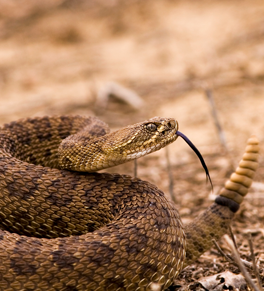What to do if you're bitten by a rattlesnake

It’s that time of year when outdoor enthusiasts hike and bike trails, enjoy the great outdoors … and sometimes cross paths with a rattlesnake.
Snake encounters typically peak in spring and summer since that’s when both humans and snakes are most active in the outdoors. And while there are no official snake counts, many wildlife officials expect that there are more of the reptiles this summer because of the heavy rains of last winter, leading to an increase in small rodents, the snakes’ prey.
Fortunately, venomous snakebites are not the most common in Southern California. Many snakes are, in fact, nonvenomous.
Rattlesnakes, of course, are venomous and usually quite easy to identify:
- Triangular-shaped head
- Spotted body
- Distinctive rattle on the tail
You should know how to respond if you or a friend is bitten by a rattlesnake.
Keep it simple
Your best rattlesnake-bite tools, according to Dr. Jeffrey Suchard, UCI Health emergency medicine physician and medical toxicologist, are simple ones:
- Car keys
- A cell phone
“There is no intervention at the scene of a venomous snakebite that is recommended,” says Suchard. “Your goal is to get to a hospital as soon as possible to be assessed for possible antivenom treatment.”
What NOT to do
In addition to Suchard’s advice, it’s equally important to know what NOT to do. This list of don’ts includes:
- Cutting an incision so you can suck out the venom – This macho treatment from old Western movies has never been effective.
- Using a snakebite kit — Commercial kits often contain a blade for making an incision, which may damage internal body structures. The kits sometimes also include suction devices, which are ineffective at removing venom.
- Applying ice — This does nothing to treat the bite and potentially leads to frostbite.
- Giving the victim alcohol, caffeine or medication — None of these is helpful.
- Applying electric shock — Suchard notes that this outdated and dangerous practice actually can denature the venom, but it also messes with important proteins in your body. Consequently, it’s not recommended.
What you should do
Snakebite symptoms include pain and swelling. These start at the wound site and may or may not travel up the bitten appendage. Sometimes, you develop a muscle twitch.
In an ideal venomous snakebite situation, the victim should sit down and rest, keeping the wound below heart level, while an ambulance is called.
In Suchard’s experience, this scenario only occasionally happens. Instead, hikers and mountain bikers may be some distance away from their car and out of cell phone range when they are bitten. So what to do in these situations?
- First, don’t panic. Death by rattlesnake bite is extremely rare.
- If your symptoms are mild and you can walk or ride your bike out, by all means do so.
- For more severe bites, you could try creating a splint to immobilize the bitten appendage, but this is seldom necessary.
- In all cases, it’s a good idea to lightly wrap the wound with gauze.
- When cell service becomes available, call 911. You can either request an ambulance ride from the trailhead or, in dire situations, medical evacuation. In the most favorable circumstances, you may want to simply get directions to the nearest medical facility offering antivenom treatment.
Snakebite treatment
Once at the hospital, you will be assessed for possible antivenom treatment. This outcome is based on the severity of your outward symptoms and the results of one or more blood tests.
The concern is that envenomation (i.e., the presence of venom in your body) can cause your blood’s platelet and fibrinogen counts to drop to dangerous levels, which can lead to hemorrhaging.
Snakebite symptoms can take quite a while to manifest, so you will likely be observed and retested for a minimum of four to six hours. Severe bites may require several days of hospitalization to ensure you have received sufficient antivenom treatment.
Bitten by a nonvenomous snake? Just treat it in the field like any puncture wound: clean the bite area and apply a loose bandage.
Should you ID the snake species?
Southern California is home to a handful of rattlesnake species, including the Southern Pacific, red diamond and southwestern speckled. These natives are part of the pit viper family, and the same antivenom works for all of them.
Do not attempt to kill or trap the snake for identification purposes – there is no need for this.
Suchard and his colleagues still recall the time a well-intentioned bite victim brought a live rattlesnake inside a plastic container into the UC Irvine Medical Center emergency room. The reptile’s presence created only danger, not help.
Preventing a snake bite
Of course, the best snakebite advice is to actively avoid getting bit in the first place.
This means staying alert to your surroundings and keeping a safe distance from a rattlesnake should you spot one. It’s best to wear sturdy shoes and long, loose-fitting pants when exploring trails or rural properties.
Further, never taunt a rattlesnake. According to Suchard, the telltale sign of a snake provoker is someone who receives a bite in the face or arms. Don’t be that someone.




